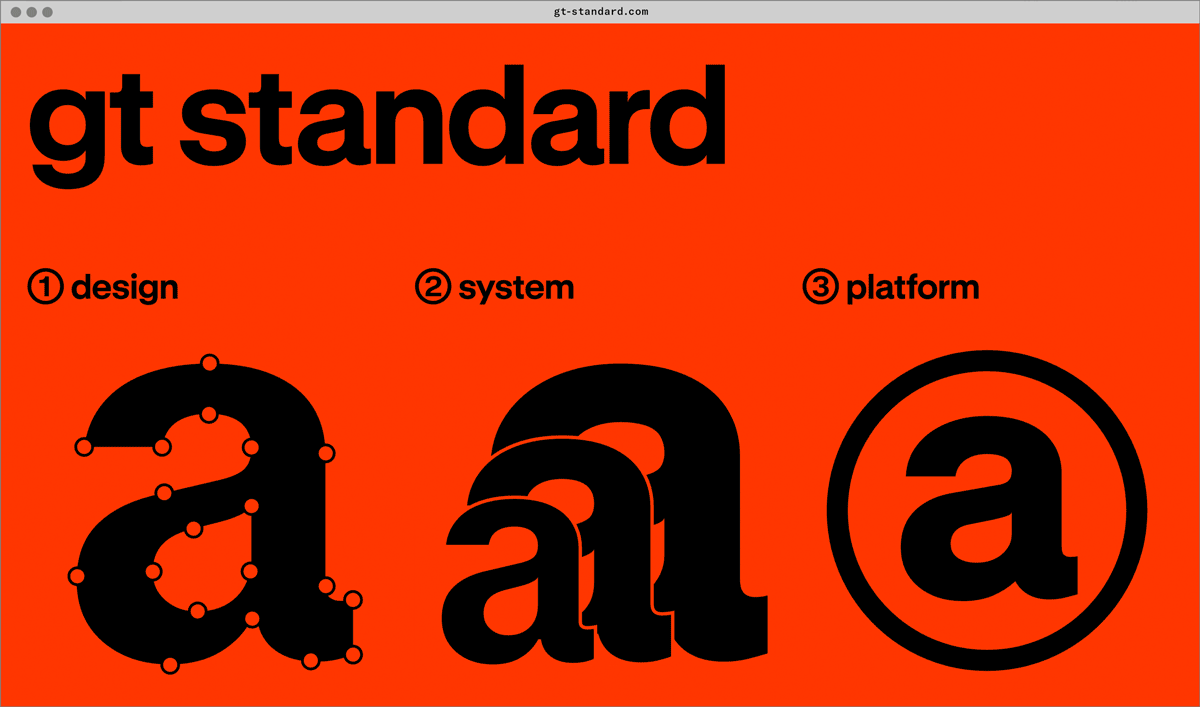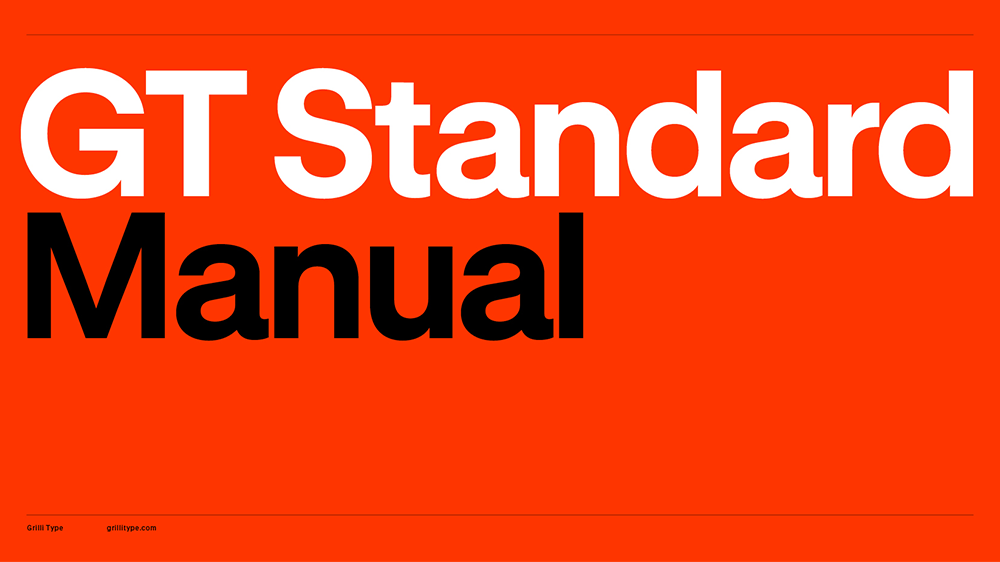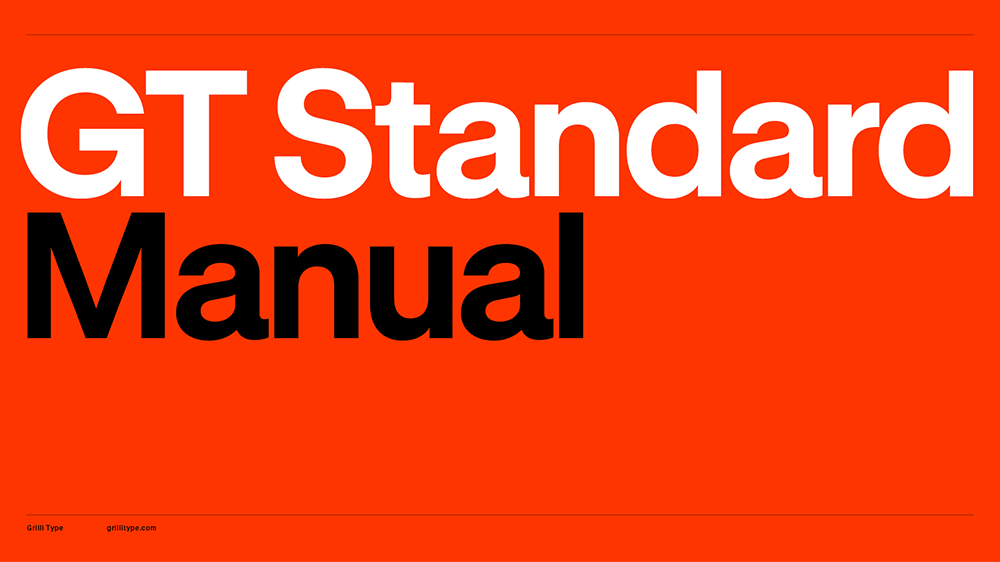GT Standard
Family overview
- Compressed
- S Light Oblique
- M Light Oblique
- L Light Oblique
- S Regular Oblique
- M Regular Oblique
- L Regular Oblique
- S Medium Oblique
- M Medium Oblique
- L Medium Oblique
- S Semibold Oblique
- M Semibold Oblique
- L Semibold Oblique
- S Bold Oblique
- M Bold Oblique
- L Bold Oblique
- S Heavy Oblique
- M Heavy Oblique
- L Heavy Oblique
- S Black Oblique
- M Black Oblique
- L Black Oblique
- Condensed
- S Light Oblique
- M Light Oblique
- L Light Oblique
- S Regular Oblique
- M Regular Oblique
- L Regular Oblique
- S Medium Oblique
- M Medium Oblique
- L Medium Oblique
- S Semibold Oblique
- M Semibold Oblique
- L Semibold Oblique
- S Bold Oblique
- M Bold Oblique
- L Bold Oblique
- S Heavy Oblique
- M Heavy Oblique
- L Heavy Oblique
- S Black Oblique
- M Black Oblique
- L Black Oblique
- Narrow
- S Light Oblique
- M Light Oblique
- L Light Oblique
- S Regular Oblique
- M Regular Oblique
- L Regular Oblique
- S Medium Oblique
- M Medium Oblique
- L Medium Oblique
- S Semibold Oblique
- M Semibold Oblique
- L Semibold Oblique
- S Bold Oblique
- M Bold Oblique
- L Bold Oblique
- S Heavy Oblique
- M Heavy Oblique
- L Heavy Oblique
- S Black Oblique
- M Black Oblique
- L Black Oblique
- Standard
- S Light Oblique
- M Light Oblique
- L Light Oblique
- S Regular Oblique
- M Regular Oblique
- L Regular Oblique
- S Medium Oblique
- M Medium Oblique
- L Medium Oblique
- S Semibold Oblique
- M Semibold Oblique
- L Semibold Oblique
- S Bold Oblique
- M Bold Oblique
- L Bold Oblique
- S Heavy Oblique
- M Heavy Oblique
- L Heavy Oblique
- S Black Oblique
- M Black Oblique
- L Black Oblique
- Extended
- S Light Oblique
- M Light Oblique
- L Light Oblique
- S Regular Oblique
- M Regular Oblique
- L Regular Oblique
- S Medium Oblique
- M Medium Oblique
- L Medium Oblique
- S Semibold Oblique
- M Semibold Oblique
- L Semibold Oblique
- S Bold Oblique
- M Bold Oblique
- L Bold Oblique
- S Heavy Oblique
- M Heavy Oblique
- L Heavy Oblique
- S Black Oblique
- M Black Oblique
- L Black Oblique
- Expanded
- Mono Compressed
- Light Oblique
- Regular Oblique
- Medium Oblique
- Semibold Oblique
- Bold Oblique
- Heavy Oblique
- Black Oblique
- Mono Condensed
- Light Oblique
- Regular Oblique
- Medium Oblique
- Semibold Oblique
- Bold Oblique
- Heavy Oblique
- Black Oblique
- Mono Narrow
- Light Oblique
- Regular Oblique
- Medium Oblique
- Semibold Oblique
- Bold Oblique
- Heavy Oblique
- Black Oblique
- Mono Standard
- Light Oblique
- Regular Oblique
- Medium Oblique
- Semibold Oblique
- Bold Oblique
- Heavy Oblique
- Black Oblique
- Mono Extended
- Light Oblique
- Regular Oblique
- Medium Oblique
- Semibold Oblique
- Bold Oblique
- Heavy Oblique
- Black Oblique
- Mono Expanded
Subfamilies
- Standard S LightDMX512 (commonly just DMX) with XLR connector to control and sometimes power stage and venue lights, effects, smoke machines, laser projectors, and pyrotechnics.
- Standard M LightUse of programming languages R and Python in science and engineering disciplines, other than computer science, where automated analysis of data is required, while remaining simple enough for a non-professional.
- Standard L LightA standard practice or procedure gives a set of instructions for performing operations or functions. For example, there are detailed standard operating procedures for operation of a nuclear power plant.
- Standard S Light ObliqueNot all technical standards are created equal. In the development of a technical standard, private standards adopt a non-consensus process in comparison to voluntary consensus standards.
- Standard M Light ObliqueVoluntary consensus standards quicken the market acceptance of products while making clear how to improve the safety of those products for the protection of consumers.
- Standard L Light ObliqueUSB for high speed serial interface in computers and for powering or charging low power external devices (like mobile phones, headphones, portable hard drives) usually using micro USB plug and socket.
- Standard S RegularThe people who use the item or service (engineers, trade unions, etc.) or specify it (building codes, government, industry, etc.) have the responsibility to consider the available standards, specify the correct one, enforce compliance, and use the item correctly.
- Standard M RegularThe existence of a published standard does not imply that it is always useful or correct. For example, if an item complies with a certain standard, there is not necessarily assurance that it is fit for any particular use.
- Standard L RegularWhen a geographically defined community must solve a community-wide coordination problem, it can adopt an existing standard or produce a new one.
- Standard S Regular ObliqueANSI's market-driven, decentralized approach has been criticized in comparison with more planned and organized international approaches to standardization.
- Standard M Regular ObliquePDF was first created in 1993 by Adobe. Adobe internal standards were part of its software quality systems, but they were neither published nor coordinated by a standards body.
- Standard L Regular ObliqueWhen a geographically defined community must solve a community-wide coordination problem, it can adopt an existing standard or produce a new one.
- Standard S MediumA de facto standard is a custom or convention that is commonly used even though its use is not required. De facto is a Latin phrase meaning in practice but not necessarily ordained by law, or in practice or actuality, but not officially established.
- Standard M Medium2.54 mm (0.1 inch) pin spacing on many electronic components, including DIP, SIL packages, header connectors, and many more. The standard spacing enable use of these devices in prototyping boards and standardized sockets.
- Standard L MediumFor example, there may be a specification for a turbine blade for a jet engine that defines the exact material and performance requirements.
- Standard S Medium ObliqueTechnical standards may exist as public documents on the internet, public library, etc. Some technical standards may be found at a major central library or at the library of a good technical university
- Standard M Medium ObliqueUse of programming languages R and Python in science and engineering disciplines, other than computer science, where automated analysis of data is required, while remaining simple enough for a non-professional.
- Standard L Medium ObliqueFor example, a physical property of a material is often affected by the precise method of testing: any reference to the property should therefore reference the test method used.
- Standard S SemiboldProgramming languages that have multiple implementations such as PHP tend to also have a de facto standard. In PHP's case the de facto standard is the binaries available from php.net, rather than the Phalanger implementation.
- Standard M SemiboldA standard is a basis for comparison. Standards are made either by many people that agree on something, or if some organisation makes it so.
- Standard L SemiboldTechnical barriers arise when different groups come together, each with a large user base, doing some well established thing that between them is mutually incompatible.
- Standard S Semibold ObliquePhone connector (3.5 mm jack), RCA and XLR connectors, used in the audio industry for connecting audio equipment such as headphones, mixing desks, microphones, stage lighting, etc.
- Standard M Semibold ObliqueThe people who use the item or service (engineers, trade unions, etc.) or specify it (building codes, government, industry, etc.) have the responsibility to consider the available standards, specify the correct one, enforce compliance, and use the item correctly.
- Standard L Semibold ObliqueWhen a geographically defined community must solve a community-wide coordination problem, it can adopt an existing standard or produce a new one.
- Standard S BoldBNC for medium frequency signal in electronic engineering testing (commonly used by signal generators, oscilloscopes, multimeters, etc.) and sometimes in video signal delivery between devices in studios and other professional settings.
- Standard M BoldIt is usually a formal document that establishes uniform engineering or technical criteria, methods, processes, and practices.
- Standard L BoldThe IBM Personal Computer: by one year after its 1981 release, John Dvorak described the PC as rapidly becoming a de facto standard microcomputer. With the MS-DOS and Microsoft Windows operating systems, it gained a large share of the personal computer market.
- Standard S Bold ObliquePCI Express electrical and mechanical interface, and interconnect protocol used in computers, servers, and industrial applications.
- Standard M Bold ObliqueVoluntary consensus standards quicken the market acceptance of products while making clear how to improve the safety of those products for the protection of consumers.
- Standard L Bold ObliqueA technical standard is an established norm or requirement for a repeatable technical task which is applied to a common and repeated use of rules, conditions, guidelines or characteristics for products or related processes and production methods, and related management systems practices.
- Standard S HeavyPCI Express electrical and mechanical interface, and interconnect protocol used in computers, servers, and industrial applications.
- Standard M HeavyANSI was most likely formed in 1918, when five engineering societies and three government agencies founded the American Engineering Standards Committee (AESC).
- Standard L HeavyThe people who use the item or service (engineers, trade unions, etc.) or specify it (building codes, government, industry, etc.) have the responsibility to consider the available standards, specify the correct one, enforce compliance, and use the item correctly.
- Standard S Heavy ObliqueGPIB, multi-device bus protocol, mechanical and electronic interface commonly found in electronic test equipment, e.g. digital multimeters, oscilloscopes, etc. Initially created by Hewlett Hewlett-Packard as HP-IP. Commonly used with SCPI protocol.
- Standard M Heavy ObliqueMIDI connection (using DIN connector or Phone connector), electrical and protocol standard for connecting musical instruments, synthesizers, drum machines, sequencers, and some audio equipment.
- Standard L Heavy ObliqueA technical standard is an established norm or requirement for a repeatable technical task which is applied to a common and repeated use of rules, conditions, guidelines or characteristics for products or related processes and production methods, and related management systems practices.
- Standard S BlackProgramming languages that have multiple implementations such as PHP tend to also have a de facto standard. In PHP's case the de facto standard is the binaries available from php.net, rather than the Phalanger implementation.
- Standard M BlackMIDI connection (using DIN connector or Phone connector), electrical and protocol standard for connecting musical instruments, synthesizers, drum machines, sequencers, and some audio equipment.
- Standard L BlackStandards often get reviewed, revised and updated on a regular basis. It is critical that the most current version of a published standard be used or referenced.
- Standard S Black ObliqueProgramming languages that have multiple implementations such as PHP tend to also have a de facto standard. In PHP's case the de facto standard is the binaries available from php.net, rather than the Phalanger implementation.
- Standard M Black ObliqueMicrosoft has repeatedly internally changed the file specification between versions of Word to suit their own needs, while continuing to reuse the same file extension identifier for different versions.
- Standard L Black ObliqueUse of programming languages R and Python in science and engineering disciplines, other than computer science, where automated analysis of data is required, while remaining simple enough for a non-professional.
- Settings
Typeface information
GT Standard is a contemporary response to the modernist pursuit of standardization. It’s rooted in the principles of Swiss Style and expands on this legacy to meet the needs of today’s visual landscape. The typeface is systematic yet expressive, built for clarity, adaptability, and precision across every scale and medium.
Typeface features
OpenType features enable smart typography. You can use these features in most Desktop applications, on the web, and in your mobile apps. Each typeface contains different features. Below are the most important features included in GT Standard’s fonts:
- SS01
- Alternate a
Regards
- SS02
- Alternate g
Engaging
- SS03
- Alternate y
Energy
- SS04
- Alternate Q
Quality
- SS06
- Rectangular Dots
Minimalism
- SS07
- Account Spoofing
Informal
Typeface Minisite


- Visit the GT Standard minisite to discover more about the typeface family’s history and design concept.

